Physical Address
304 North Cardinal St.
Dorchester Center, MA 02124
Not surprisingly, the lung is a source of virtually all described mesenchymal tumors. Although leiomyomas, schwannomas, lipomas, neurofibromas, hemangiomas, and lymphangiomas can originate in the lung, one should be certain that such lesions are not metastatic low-grade sarcomas, especially the smooth muscle tumors. Pulmonary hamartomas are the most common benign lung tumors and warrant further discussion. Chondromas are discussed within the differential diagnosis of hamartomas.
Benign neoplasm composed of varying proportions of mesenchymal tissues combined with entrapped respiratory epithelium (World Health Organization)
The incidence is 0.32%
Twofold to fourfold male predominance
Peak incidence is in the sixth or seventh decade of life
Rare cases have been reported in children as young as 9 years old
Usually asymptomatic
Endobronchial lesions may present with cough, hemoptysis, or obstructive pneumonia
Usually well-circumscribed, smoothly marginated, solitary peripheral nodules measuring less than 4.0 cm
A small percentage demonstrates radiographic calcifications, including so-called diagnostic popcorn calcifications
Rarely multiple lesions
Hamartomas are slow-growing, benign neoplasms amenable to conservative surgical resection
Sleeve excision or lobectomy may be required, depending on the size and/or location of the tumor and peritumoral findings
Sarcomatous transformation of adenocarcinomas arising in hamartomas are exceedingly rare events
Parenchymal tumors are multilobulated, semifirm, white or gray
Endobronchial tumors are polypoid and usually soft yellow
Tumors are usually less than 4.0 cm
Lobulated masses of mature hyaline cartilage surrounded by fat, smooth muscle, bone, or fibrovascular tissue
Punctate calcifications
Peripheral clefts lined by respiratory-type epithelium
Endobronchial tumors more lipomatous with shallow or absent epithelial invaginations
Biphasic smears with epithelial and mesenchymal tissue
Cartilage and fibromyxoid tissue prominent on Diff-Quik smears
Epithelium can be abundant and reactive
Background without blood, necrosis, or inflammation
Cell block highlights benign mesenchymal and epithelial tissue
Monomorphic benign soft tissue tumors, especially chondroma
Chondrosarcoma
Pulmonary hamartomas are benign neoplasms composed of varying amounts of at least two mesenchymal elements (such as cartilage, fat, connective tissue, or smooth muscle), combined with entrapped respiratory epithelium. Although the World Health Organization prefers the nosologically incorrect term hamartoma, synonyms include chondroid hamartoma, benign mesenchymoma, and hamartochondroma. With a population incidence of 0.32%, a twofold to fourfold male predominance is observed. The peak incidence is in the sixth or seventh decade of life; yet rare cases have been reported in children as young as 9 years old. Most patients with hamartomas are asymptomatic because tumors are often peripheral coin lesions, and almost all are incidentally discovered on chest radiographs. Approximately 10% are endobronchial and these may present with cough, hemoptysis, or obstructive pneumonia. Hamartomas are rarely multiple. Associations with other pulmonary diseases, including lung cancer or malignant transformation, have not been convincingly demonstrated.
Pulmonary hamartomas are usually well circumscribed, smoothly marginated, solitary peripheral nodules measuring less than 4.0 cm and represent up to 14% of so-called coin lesions. A small percentage demonstrates radiographic calcifications, including so-called diagnostic popcorn calcifications.
Well-circumscribed and lobulated peripheral hamartomas are surrounded by compressed lung parenchyma. These bulging tumors can often be shelled out from surrounding lung parenchyma and usually are not connected to airways. Cut surfaces range from semifirm white and pearly in tumors with large amounts of cartilage to tan and gelatinous in cartilage-poor lesions ( Fig. 31.1A ). Gritty specks are also appreciated in those cases with calcification. Focal cystic change is often seen, whereas rare tumors may be largely cystic with interspersed solid areas. Endobronchial lesions are often fleshy, yellow, and glistening due to the large amount of adipose tissue in the tumor. These tumors are usually found in the large central airways and are broad-based polyps.
Hamartomas are composed of varying proportions of benign mesenchyme, including cartilage, adipose tissue, smooth muscle, bone, and fibrovascular tissue ( Fig. 31.1A ). In most peripheral lesions, one sees lobulated masses of mature cartilage surrounded by strands or islands of fibromyxoid connective tissue, fat, bone, and smooth muscle ( Fig. 31.1B ). The edges of the lesion feature cleftlike spaces or invaginations of respiratory-type epithelium ( Fig. 31.1C ). Rare peripheral hamartomas without cartilage must demonstrate at least two mesenchymal elements such as adipose tissue, smooth muscle, or primitive fibromyxoid tissue in order to diagnose this entity. Up to 15% of tumors feature calcification.
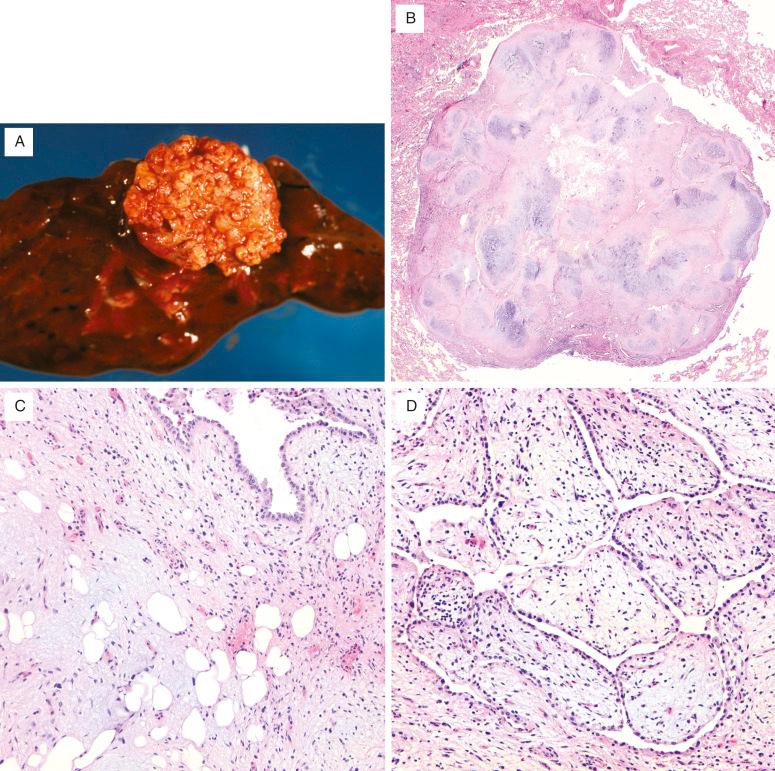
Endobronchial lesions differ from parenchymal lesions in several aspects. These polypoid tumors often feature large amounts of mature adipose tissue surrounded by a compressed layer of myxoid tissue, whereas smooth muscle and seromucinous glands may be admixed. Cartilage is either absent or present in very small amounts. Rarely, the cartilage shows increased cellularity and/or nuclear pleomorphism but certainly not malignant features. Although attached to the bronchial wall, these central lesions are not continuous with bronchial cartilage plates. Epithelial invaginations, if present, are shallow, and surface epithelium is intact.
Hamartomas often have the t(3;12)(q27–28;q14–15) translocation, which results in gene fusion of the high-mobility group protein gene HMGA2 and the LPP gene. This fusion usually contains exons 1 to 3 of HMGA2 and exons 9 to 11 of LLP.
In theory, fine-needle aspiration biopsy (FNAB) diagnosis of pulmonary hamartoma is quite simple because one needs only to recognize nonorganized epithelial and mesenchymal tissues on smears and/or cell blocks ( Fig. 31.2 ). However, many pitfalls exist (evidenced by a false-positive rate of over 20%), and extreme caution in addition to radiographic correlation is recommended in each case. Whereas Diff-Quik–stained smears highlight the cartilaginous/fibromyxoid material, these elements may be subtle on Papanicolaou-stained smears. Also, the invaginated epithelium accompanying lesions can be plentiful and reactive and thus easily mistaken for adenocarcinoma or even carcinoid tumor. The absence of background necrosis, blood, and inflammation should aid in avoiding a diagnosis of malignancy, whereas a cell block should highlight the mesenchymal elements and nonneoplastic nature of the epithelium.
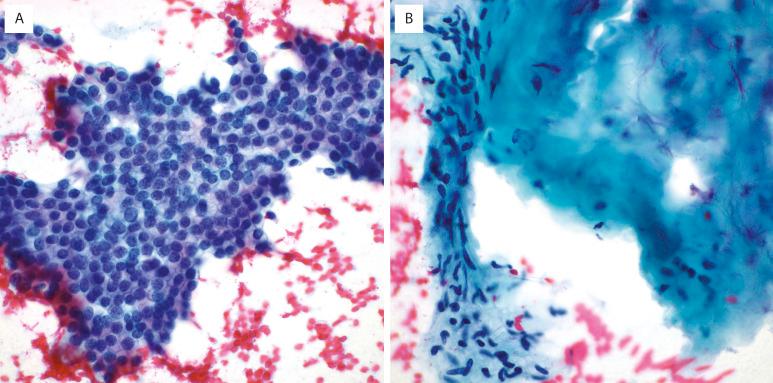
Pulmonary hamartoma should be distinguished from monomorphic soft tissue tumors, including bronchial chondromas and chondrosarcoma. Chondromas occur in young patients, primarily women, in the setting of Carney triad (pulmonary chondromas, gastrointestinal stromal tumors, and extraadrenal paragangliomas) but can also occur sporadically. Chondromas, unlike hamartomas, arise from and lie in continuity with bronchial cartilage, lack invaginated respiratory epithelium, and never contain other mesenchymal elements ( Fig. 31.3 ). Whereas central hamartomas may feature increased chondrocyte cellularity and cytologic atypia, features diagnostic of chondrosarcoma in other anatomic locations, these findings are not indicative of malignancy as long as one correctly identifies another mesenchymal element in the tumor.
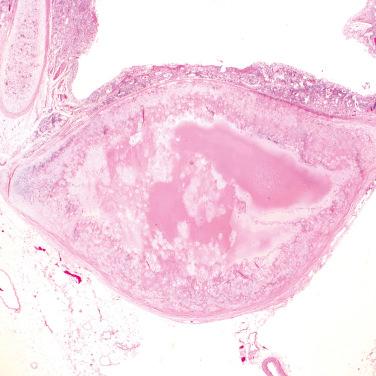
Pulmonary hamartomas are slow-growing benign neoplasms amenable to conservative surgical resection. In some instances sleeve excision or lobectomy may be required, depending on the size and/or location of the tumor and peritumoral findings. Sarcomatous transformation of and adenocarcinomas arising in hamartomas are exceedingly rare events such that many radiographically detected and FNAB-proven tumors are followed rather than resected. Although it has been suggested that patients with hamartomas are at increased risk for subsequent lung cancer, supportive epidemiologic or pathologic evidence is lacking.
Seromucinous glands within the walls of large bronchi can give rise to virtually any of the recognized benign salivary gland–type neoplasms. Pleomorphic adenomas (PAs), monomorphic adenomas, oncocytomas, myoepitheliomas, and adenomyoepitheliomas are extremely rare primary lung tumors.
Benign tumors that are thought to arise out of minor salivary glands
Rare
Five cases reported
Case reports found only in women, 50 to 60 years
Asymptomatic single or multiple nodules
Incidental single mass or multiple masses found on imaging studies
Complete resection resulted in no recurrence
Well-circumscribed, tan/white masses that bulge out from the surrounding lung
Intermixed bland glandular and spindle cell epithelium
The glandular epithelium surrounds lumens that have an abundance of eosinophilic, colloid-type material
Glandular epithelium is positive for CK7, CAM 5.2, TTF-1, and SP-A.
The outer layer of cells and the spindled cells are positive for myoepithelial markers (SMA, S100, and calponin).
Pulmonary sclerosing pneumocytomas
Neuroendocrine tumors such as carcinoids
Metastatic tumors to the lung with colloid such as metastatic thyroid carcinomas
Pneumocytic adenomyoepithelioma (PAM) is a rare benign tumor with epithelial and myoepithelial elements that is thought to arise out of minor salivary glands of the proximal airways in the lung.
All patients reported to date are women 50 to 60 years of age.
The cases reported to date have a similar gross appearance. They are well-circumscribed, tan/white masses that bulge out from the surrounding lung. Some are solid and others have a more papillary gross appearance with a variegated surface. They may be single or multiple nodules and range in size from 0.8 to 2.6 cm.
Histologically, the tumor has areas of intermixed bland glandular and spindle cell epithelium. The glandular epithelium surrounds lumens that have an abundance of eosinophilic, colloid-type material. The glandular epithelium is composed of a double layer of pneumocytic cells with mild cytologic atypia ( Fig. 31.4 ).
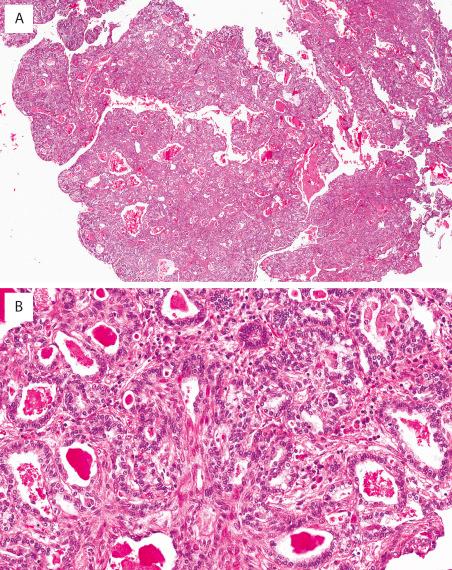
Immunohistochemical studies reveal the inner layer of glandular epithelium is positive for CK7, CAM 5.2, thyroid transcription factor (TTF-1), and SP-A. The outer layer of cells and the spindled cells are positive for myoepithelial markers, including smooth muscle actin (SMA), S100, and calponin.
The pathologic differential diagnosis includes pulmonary sclerosing pneumocytomas (SPs); however, these do not show myoepithelial differentiation by immunohistochemistry. Neuroendocrine tumors such as carcinoids may be mistaken for the spindled cell component of PAMs; however, PAM spindled cells are negative for all neuroendocrine antibodies. Metastatic tumors to the lung with colloid, such as metastatic thyroid carcinomas, may be in the differential diagnosis. However, both myoepithelial and surfactant antibodies do not stain these tumors.
In all patients reported, complete resection resulted in no recurrence.
Pleomorphic adenomas primary to the lung are very rare, documented only as single case reports
Rare, with fewer than 20 cases reported in the literature
Dyspnea or asthmalike symptoms
Proximal airway masses or obstruction
Complete surgical resection is curative procedure
Rare reports of recurrence years after resection, especially at the line of resection
Polypoid masses growing out of proximal airways
Soft and usually lobulated polyps of 1 to 1.5 cm
Less likely to feature either a prominent glandular component or chondroid stroma
Cellular mixed tumor with sheets or islands of epithelial and/or myoepithelial cells and a myxoid matrix
Positive for S-100 protein, cytokeratin, actin, GFAP, and vimentin
Metastases from the head and neck
Mucoepidermoid tumors
Adenoid cystic carcinomas
Biphasic carcinosarcomas
PAs primary to the lung are very rare, documented only as single case reports. These tumors occur in adults 40 to 70 years of age, who usually present with cough or intermittent dyspnea, sometimes resembling asthma.
Rare case reports have documented polypoid masses growing out of proximal airways. These masses are soft and usually lobulated polyps of 1 to 1.5 cm ( Fig. 31.5A ).
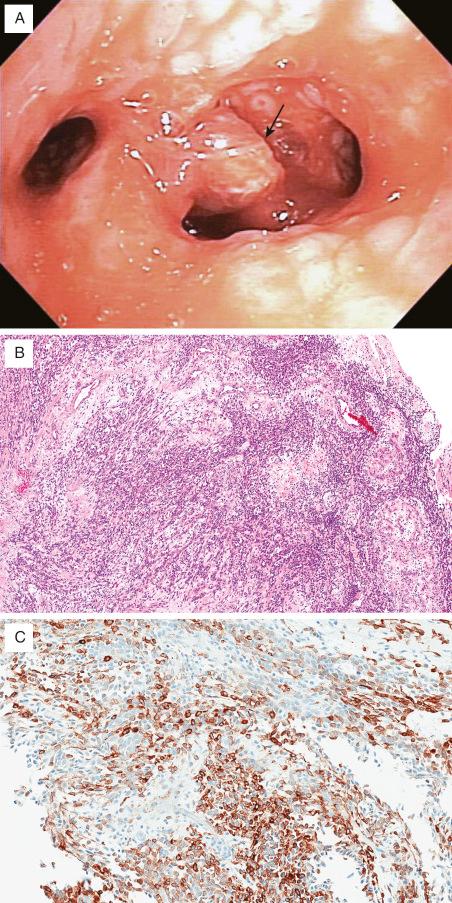
Primary endobronchial or peripheral PAs are less likely to feature either a prominent glandular component or chondroid stroma than the salivary gland counterpart and rather resemble “cellular mixed tumor” with sheets or islands of epithelial and/or myoepithelial cells and a myxoid matrix ( Fig. 31.5B and C ).
Immunohistochemical studies of primary pulmonary PAs reveal similar findings to those in the salivary glands with the glandular elements positive for S-100 protein, cytokeratin, actin, glial fibrillary acidic protein (GFAP), and vimentin.
The differential diagnosis must always include metastases from the head and neck, especially for those masses that occur outside of the proximal airways. In addition, mucoepidermoid tumors, adenoid cystic carcinomas (ACC), and biphasic carcinosarcomas are in the differential diagnosis. PAs are best distinguished from ACC by positivity for GFAP and from mucoepidermoid carcinomas from their S-100, actin, and GFAP positivity.
Complete surgical resection of a PA is considered a curative procedure. However, there are rare reports of recurrence years after resection, especially at the line of resection.
Benign, predominantly exophytic tumor of the tracheobronchial seromucinous glands and ducts, composed of mucus-filled cysts, tubules, glands, and papillary formations lined by a spectrum of benign epithelium (World Health Organization)
Rare
In the largest series, women outnumbered men by 2.5 to 1
Reported in children and the elderly with a mean age of 52 years
Obstructive symptoms
Coin lesion or endobronchial mass in lobar or segmental bronchi with distal parenchymal consolidation
Should be conservatively resected via bronchoscopic extirpation or sleeve resection
Lobectomy may be required if the peripheral lung is extensively damaged
Endobronchial tumors are white to tan with solid and cystic gelatinous surfaces
Well-circumscribed, noninvasive tumors located above bronchial cartilage
Mucin-filled cysts may resemble colloid
Epithelium may be tubulocystic or papillocystic
Columnar, cuboidal, or flattened mucus-secreting cells line cysts
Stroma is fibrous or hyalinized
Epithelial component positive for cytokeratin, EMA, and CEA but not TTF-1
Stromal component focally positive for SMA and S-100 protein
Mucoepidermoid carcinoma
Adenocarcinoma
This rare endobronchial tumor has been reported in children and the elderly with a mean age of 52 years. Thought to arise from bronchial mucus glands, most tumors are central, but peripheral lesions have been described. In the largest series, women outnumbered men by 2.5 to 1. Individuals present with obstructive symptoms, and radiographic studies may demonstrate a coin lesion or endobronchial mass in lobar or segmental bronchi with distal parenchymal consolidation.
Tumors range in size from 0.7 to 7.5 cm with a mean diameter of 2.3 cm. The white-pink to tan, smooth, and shiny tumors have solid and cystic gelatinous cut surfaces.
Mucous gland adenomas are well circumscribed and noninvasive exophytic masses located above the cartilage plates of the bronchial wall. Numerous neutral and acid mucin–filled cystic spaces protrude into bronchial lumens with an intact overlying respiratory epithelium ( Fig. 31.6A ). Tubulocystic and papillocystic appearances are also common. Cysts are lined by cytologically bland columnar, cuboidal, or flattened mucus-secreting cells ( Fig. 31.6B ). Oncocytic and clear cell changes are often observed. Intervening stroma is usually fibrous or hyalinized, and cyst contents may resemble colloid. Hyperchromasia, pleomorphism, and mitoses are not seen.
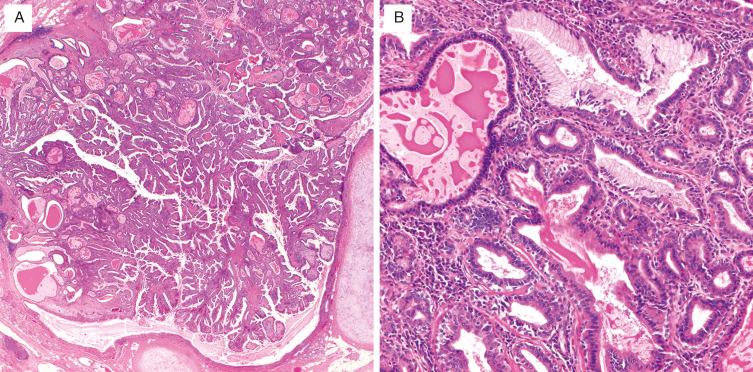
Epithelial cells stain for cytokeratin, epithelial membrane antigen (EMA), and carcinoembryonic antigen (CEA) but not TTF-1, whereas stromal cells are focally positive for SMA and S-100 protein. This latter finding indicates a myoepithelial component.
Mucoepidermoid carcinoma and adenocarcinoma comprise the morphologic differential diagnosis. Low-grade mucoepidermoid carcinoma may be predominantly glandular with dilated cysts, and distinction on endobronchial biopsy is probably not possible. Despite the architectural similarities, squamous and intermediate cells are only seen in mucoepidermoid carcinoma. Adenocarcinomas are rarely entirely exophytic without underlying invasion and feature cytologic atypia, mitoses, and necrosis.
Become a Clinical Tree membership for Full access and enjoy Unlimited articles
If you are a member. Log in here